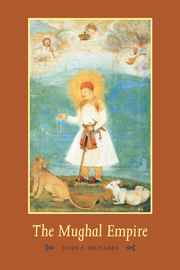Crossref Citations
This Book has been
cited by the following publications. This list is generated based on data provided by Crossref.
Ludden, David
1994.
History outside civilisation and the mobility of South Asia∗.
South Asia: Journal of South Asian Studies,
Vol. 17,
Issue. 1,
p.
1.
Gommans, Jos
1995.
Trade and Civilization around the Bay of Bengal, c. 1650–1800.
Itinerario,
Vol. 19,
Issue. 3,
p.
82.
Dale, Stephen F.
1996.
The Poetry and Autobiography of theBâbur-nâma.
The Journal of Asian Studies,
Vol. 55,
Issue. 3,
p.
635.
Barbour, Richmond
1998.
Power and Distant Display: Early English "Ambassadors" in Moghul India.
Huntington Library Quarterly,
Vol. 61,
Issue. 3/4,
p.
343.
Schweer, Thomas
1999.
Metzler Lexikon Religion.
p.
82.
Brown, Katherine
2000.
Reading Indian music: The interpretation of seventeenth‐century European travel‐writing in the (re)construction of Indian music history.
British Journal of Ethnomusicology,
Vol. 9,
Issue. 2,
p.
1.
Dale, Stephen
2000.
The New Cambridge History of Islam.
p.
266.
Morgan, David O.
and
Reid, Anthony
2000.
The New Cambridge History of Islam.
Levi, Scott C.
2000.
The New Cambridge History of Islam.
p.
561.
Maskiell, Michelle
and
Mayor, Adrienne
2001.
Killer Khilats, Part 1: Legends of Poisoned "Robes of Honour" in India.
Folklore,
Vol. 112,
Issue. 1,
p.
23.
Robb, Peter
2002.
A History of India.
p.
116.
Robb, Peter
2002.
A History of India.
p.
81.
Lambourn, Elizabeth
2003.
Of Jewels and Horses: The Career and Patronage of an Iranian Merchant under Shah Jahan.
Iranian Studies,
Vol. 36,
Issue. 2,
p.
213.
Stevens, Paul
2004.
Imperialisms.
p.
93.
Mielants, Eric
2005.
The Historical Evolution of World-Systems.
p.
122.
Schweer, Thomas
2005.
Metzler Lexikon Religion.
p.
614.
2006.
A Companion to the Reformation World.
p.
506.
Kela, Shashank
2006.
Adivasi and peasant: Reflections on Indian social history.
Journal of Peasant Studies,
Vol. 33,
Issue. 3,
p.
502.
Sinopoli, Carla M.
2006.
Archaeology of Asia.
p.
324.
Clydesdale, Greg
2007.
What Happened to Indian Supremacy? The Systemic Loss of Prosperity.
Journal of the Asia Pacific Economy,
Vol. 12,
Issue. 3,
p.
305.



